The Effectiveness of a Digital Twin Learning System in Assisting Engineering Education Courses: A Case of Landscape Architecture
Abstract
:1. Introduction
- How is the digital twin learning system applied in project-based courses in landscape architecture?
- Can the digital twin learning system improve students’ academic performance, critical thinking, cognitive load, learning experience, and other variables?
- Do learners accept the digital twin learning system and influencing factors?
2. Literature Review
2.1. The Application of Digital Twin Technology in Education
2.2. Digital Twin Technology in Landscape Architecture Technology Programs
2.2.1. Optimizing Synergy in Landscape Architecture
2.2.2. Real-Time Monitoring of Plant-Growth Environment
2.2.3. Enhancing the Effectiveness of the Garden-Production Program
2.3. Integration of Project-Based Teaching and Digital Twin Technology
3. Research Methods
3.1. Experimental Design
3.1.1. Content of Experimental Design
3.1.2. UTAUT2 Model and the Assumptions
4. Content and Results of Research
4.1. Content of Research
4.1.1. Framework Construction of Project-Based Teaching Model Driven by Digital Twin Technology
4.1.2. Development of a Digital Twin Garden-Learning System
4.1.3. Course Flow Design
- (1)
- Selection of projects
- (2)
- Teaching process design
4.2. Results of Research
4.2.1. Results of the Experiment
- (1)
- Cognitive Load
- (2)
- Creative Thinking Tendency
- (3)
- Learning Experience
- (4)
- Critical Thinking
- (5)
- Academic Performance
4.2.2. Structural Equation Results
5. Discussion
5.1. Discussion of Findings
5.2. Research Innovativeness
5.3. Shortcomings of the Study and Future Directions
- (1)
- The digital twin learning system developed in this study still has deficiencies in providing an immersive experience. Students may not fully immerse themselves in the virtual environment, which could negatively affect their learning experience and outcomes. The lack of immersion in the current system may be due to technical limitations or design flaws. In the future, more advanced virtual reality (VR) and augmented reality (AR) technologies could be applied to enhance the system’s immersion. System optimization based on user feedback, improving interactive design and operational processes, will make the system more seamless and intuitive for students.
- (2)
- This study did not adequately consider that learning modes may vary by age group and gender, overlooking the different needs and responses of students of different genders and ages when using the digital twin learning system. Future research should examine the experiences and outcomes of individuals from various gender and age groups when using the digital twin learning system.
- (3)
- The sample size of this study was relatively small, consisting of only 70 students from a single vocational high school. This limitation may affect the representativeness and generalizability of the findings. Future research should aim to expand the sample size to include more students from various disciplines and institutions to enhance the representativeness of the results. Conducting large-scale empirical studies will help verify the broad applicability of the system.
6. Conclusions
Author Contributions
Funding
Institutional Review Board Statement
Informed Consent Statement
Data Availability Statement
Conflicts of Interest
References
- Durão, L.F.C.; Haag, S.; Anderl, R.; Schützer, K.; Zancul, E. Digital twin requirements in the context of industry 4.0. In Proceedings of the Product Lifecycle Management to Support Industry 4.0: 15th IFIP WG 5.1 International Conference, PLM 2018, Turin, Italy, 2–4 July 2018; Proceedings 15. Springer: Berlin/Heidelberg, Germany, 2018; pp. 204–214. [Google Scholar]
- Hoc, J.M. From human–machine interaction to human–machine cooperation. Ergonomics 2000, 43, 833–843. [Google Scholar] [CrossRef]
- Vilalta-Perdomo, E.; Michel-Villarreal, R.; Thierry-Aguilera, R. Integrating industry 4.0 in higher education using challenge-based learning: An intervention in operations management. Educ. Sci. 2022, 12, 663. [Google Scholar] [CrossRef]
- Wang, H.; Yang, Z.; Zhang, Q.; Sun, Q.; Lim, E. A Digital Twin Platform Integrating Process Parameter Simulation Solution for Intelligent Manufacturing. Electronics 2024, 13, 802. [Google Scholar] [CrossRef]
- Adel, A. Unlocking the future: Fostering human–machine collaboration and driving intelligent automation through industry 5.0 in smart cities. Smart Cities 2023, 6, 2742–2782. [Google Scholar] [CrossRef]
- Greco, A.; Caterino, M.; Fera, M.; Gerbino, S. Digital twin for monitoring ergonomics during manufacturing production. Appl. Sci. 2020, 10, 7758. [Google Scholar] [CrossRef]
- Grieves, M.; Vickers, J. Digital twin: Mitigating unpredictable, undesirable emergent behavior in complex systems. In Transdisciplinary Perspectives on Complex Systems: New Findings and Approaches; Springer: Cham, The Netherlands, 2017; pp. 85–113. [Google Scholar]
- Tao, F.; Cheng, J.; Qi, Q.; Zhang, M.; Zhang, H.; Sui, F. Digital twin-driven product design, manufacturing and service with big data. Int. J. Adv. Manuf. Technol. 2018, 94, 3563–3576. [Google Scholar] [CrossRef]
- Park, K.T.; Lee, J.; Kim, H.J.; Noh, S.D. Digital twin-based cyber physical production system architectural framework for personalized production. Int. J. Adv. Manuf. Technol. 2020, 106, 1787–1810. [Google Scholar] [CrossRef]
- Fuller, A.; Fan, Z.; Day, C.; Barlow, C. Digital twin: Enabling technologies, challenges and open research. IEEE Access 2020, 8, 108952–108971. [Google Scholar] [CrossRef]
- Wu, H.K.; Lee, S.W.Y.; Chang, H.Y.; Liang, J.C. Current status, opportunities and challenges of augmented reality in education. Comput. Educ. 2013, 62, 41–49. [Google Scholar] [CrossRef]
- Levac, D.E.; Huber, M.E.; Sternad, D. Learning and transfer of complex motor skills in virtual reality: A perspective review. J. Neuroeng. Rehabil. 2019, 16, 121. [Google Scholar] [CrossRef]
- Sapriati, A.; Suhandoko, A.D.J.; Yundayani, A.; Karim, R.A.; Kusmawan, U.; Mohd Adnan, A.H.; Suhandoko, A.A. The Effect of Virtual Laboratories on Improving Students’ SRL: An Umbrella Systematic Review. Educ. Sci. 2023, 13, 222. [Google Scholar] [CrossRef]
- Kingkaew, C.; Theeramunkong, T.; Supnithi, T.; Chatpreecha, P.; Morita, K.; Tanaka, K.; Ikeda, M. A Learning Environment to Promote Awareness of the Experiential Learning Processes with Reflective Writing Support. Educ. Sci. 2023, 13, 64. [Google Scholar] [CrossRef]
- Halverson, L.R.; Graham, C.R. Learner engagement in blended learning environments: A conceptual framework. Online Learn. 2019, 23, 145–178. [Google Scholar] [CrossRef]
- Kwok, P.K.; Yan, M.; Qu, T.; Lau, H.Y. User acceptance of virtual reality technology for practicing digital twin-based crisis management. Int. J. Comput. Integr. Manuf. 2021, 34, 874–887. [Google Scholar] [CrossRef]
- Zhu, H. Application of Rain classroom in formal classroom learning in the teaching of offshore engineering environment and loads. Comput. Appl. Eng. Educ. 2021, 29, 603–612. [Google Scholar] [CrossRef]
- Wahbeh, W.; Kunz, D.; Hofmann, J.; Bereuter, P. Digital twinning of the built environment—An interdisciplinary topic for innovation in didactics. ISPRS Ann. Photogramm. Remote Sens. Spat. Inf. Sci. 2020, 4, 231–237. [Google Scholar] [CrossRef]
- Onaji, I.; Tiwari, D.; Soulatiantork, P.; Song, B.; Tiwari, A. Digital twin in manufacturing: Conceptual framework and case studies. Int. J. Comput. Integr. Manuf. 2022, 35, 831–858. [Google Scholar] [CrossRef]
- Lantada, A.D. Engineering education 5.0: Strategies for a successful transformative project-based learning. In Insights into Global Engineering Education after the Birth of Industry 5.0; IntechOpen: London, UK, 2022. [Google Scholar]
- Zhang, L.; Ma, Y. A study of the impact of project-based learning on student learning effects: A meta-analysis study. Front. Psychol. 2023, 14, 1202728. [Google Scholar] [CrossRef]
- Demir, C.G.; Önal, N. The effect of technology-assisted and project-based learning approaches on students’ attitudes towards mathematics and their academic achievement. Educ. Inf. Technol. 2021, 26, 3375–3397. [Google Scholar] [CrossRef]
- Razali, S.N.; Noor, H.A.M.; Ahmad, M.H.; Shahbodin, F. Enhanced student soft skills through integrated online project based collaborative learning. Int. J. Adv. Appl. Sci. 2017, 4, 59–67. [Google Scholar] [CrossRef]
- Mike, S.; Mike, C.; Rich, D.; Ed, G.; Chris, K.; Jacqueline, L.; Lui, W. Modeling, simulation, information technology & processing roadmap. Natl. Aeronaut. Space Adm. 2012, 32, 1–38. [Google Scholar]
- Shin, M.H. Effects of Project-Based Learning on Students’ Motivation and Self-Efficacy. Engl. Teach. 2018, 73, 95–114. [Google Scholar] [CrossRef]
- Geng, R.; Li, M.; Hu, Z.; Han, Z.; Zheng, R. Digital Twin in smart manufacturing: Remote control and virtual machining using VR and AR technologies. Struct. Multidiscip. Optim. 2022, 65, 321. [Google Scholar] [CrossRef]
- Madni, A.M.; Erwin, D.; Madni, A. Exploiting digital twin technology to teach engineering fundamentals and afford real-world learning opportunities. In Proceedings of the 2019 ASEE Annual Conference & Exposition, Tampa, FL, USA, 16–19 June 2019. [Google Scholar]
- Krupas, M.; Kajati, E.; Liu, C.; Zolotova, I. Towards a Human-Centric Digital Twin for Human–Machine Collaboration: A Review on Enabling Technologies and Methods. Sensors 2024, 24, 2232. [Google Scholar] [CrossRef]
- Grieves, M. Digital twin: Manufacturing excellence through virtual factory replication. White Pap. 2014, 1, 1–7. [Google Scholar]
- Hänggi, R.; Nyffenegger, F.; Ehrig, F.; Jaeschke, P.; Bernhardsgrütter, R. Smart learning factory–network approach for learning and transfer in a digital & physical set up. In Proceedings of the Product Lifecycle Management Enabling Smart X: 17th IFIP WG 5.1 International Conference, PLM 2020, Rapperswil, Switzerland, 5–8 July 2020; Revised Selected Papers 17. Springer: Berlin/Heidelberg, Germany, 2020; pp. 15–25. [Google Scholar]
- Shi, T. Application of VR image recognition and digital twins in artistic gymnastics courses. J. Intell. Fuzzy Syst. 2021, 40, 7371–7382. [Google Scholar] [CrossRef]
- Zaballos, A.; Briones, A.; Massa, A.; Centelles, P.; Caballero, V. A smart campus’ digital twin for sustainable comfort monitoring. Sustainability 2020, 12, 9196. [Google Scholar] [CrossRef]
- Ahuja, K.; Shah, D.; Pareddy, S.; Xhakaj, F.; Ogan, A.; Agarwal, Y.; Harrison, C. Classroom digital twins with instrumentation-free gaze tracking. In Proceedings of the 2021 Chi Conference on Human Factors in Computing Systems, Yokohama Japan, 8–13 May 2021; pp. 1–9. [Google Scholar]
- Bevilacqua, M.G.; Russo, M.; Giordano, A.; Spallone, R. 3D reconstruction, digital twinning, and virtual reality: Architectural heritage applications. In Proceedings of the 2022 IEEE Conference on Virtual Reality and 3D User Interfaces Abstracts and Workshops (VRW), Christchurch, New Zealand, 12–16 March 2022; IEEE: Piscataway, NJ, USA, 2022; pp. 92–96. [Google Scholar]
- Schnabel, M.A.; Kvan, T. Spatial understanding in immersive virtual environments. Int. J. Archit. Comput. 2003, 1, 435–448. [Google Scholar] [CrossRef]
- Zheng, X.; Lu, J.; Kiritsis, D. The emergence of cognitive digital twin: Vision, challenges and opportunities. Int. J. Prod. Res. 2022, 60, 7610–7632. [Google Scholar] [CrossRef]
- Lu, Q.V.; Parlikad, A.K.; Woodall, P.; Ranasinghe, G.D.; Heaton, J. Developing a dynamic digital twin at a building level: Using Cambridge campus as case study. In Proceedings of the International Conference on Smart Infrastructure and Construction 2019 (ICSIC) Driving Data-Informed Decision-Making, Cambridge, UK, 8–10 July 2019; ICE Publishing: Miami Lakes, FL, USA, 2019; pp. 67–75. [Google Scholar]
- Hazrat, M.; Hassan, N.; Chowdhury, A.A.; Rasul, M.; Taylor, B.A. Developing a skilled workforce for future industry demand: The potential of digital twin-based teaching and learning practices in engineering education. Sustainability 2023, 15, 16433. [Google Scholar] [CrossRef]
- Dang, A.; Wang, F. Information technology methods for locality preservation and inheritance of settlement cultural landscape. Indoor Built Environ. 2021, 30, 437–441. [Google Scholar] [CrossRef]
- Rao, Y.; Redmon, R.; Dale, K.; Haupt, S.E.; Hopkinson, A.; Bostrom, A.; Boukabara, S.; Geenen, T.; Hall, D.M.; Smith, B.D.; et al. Developing Digital Twins for Earth Systems: Purpose, Requisites, and Benefits. arXiv 2023, arXiv:2306.11175. [Google Scholar]
- Antrop, M. Antrop, M. A brief history of landscape research. In The Routledge Companion to Landscape Studies; Routledge: London, UK, 2018; pp. 1–15. [Google Scholar]
- Leng, J.; Wang, D.; Shen, W.; Li, X.; Liu, Q.; Chen, X. Digital twins-based smart manufacturing system design in Industry 4.0: A review. J. Manuf. Syst. 2021, 60, 119–137. [Google Scholar] [CrossRef]
- Thorlindsson, T.; Halldorsson, V.; Sigfusdottir, I.D. The sociological theory of craftsmanship: An empirical test in sport and education. Sociol. Res. Online 2018, 23, 114–135. [Google Scholar] [CrossRef]
- Bronstein, L.R. A model for interdisciplinary collaboration. Soc. Work. 2003, 48, 297–306. [Google Scholar] [CrossRef] [PubMed]
- Kikuchi, N.; Fukuda, T.; Yabuki, N. Future landscape visualization using a city digital twin: Integration of augmented reality and drones with implementation of 3D model-based occlusion handling. J. Comput. Des. Eng. 2022, 9, 837–856. [Google Scholar] [CrossRef]
- Hananto, A.L.; Tirta, A.; Herawan, S.G.; Idris, M.; Soudagar, M.E.M.; Djamari, D.W.; Veza, I. Digital Twin and 3D Digital Twin: Concepts, Applications, and Challenges in Industry 4.0 for Digital Twin. Computers 2024, 13, 100. [Google Scholar] [CrossRef]
- Walliss, J.; Rahmann, H. Landscape Architecture and Digital Technologies: Re-Conceptualising Design and Making; Routledge: London, UK, 2016. [Google Scholar]
- Martínez-Gutiérrez, A.; Díez-González, J.; Perez, H.; Araújo, M. Towards industry 5.0 through metaverse. Robot.-Comput.-Integr. Manuf. 2024, 89, 102764. [Google Scholar] [CrossRef]
- Lyu, B.; Wang, Y. Immersive visualization of 3D subsurface ground model developed from sparse boreholes using virtual reality (VR). Undergr. Space 2024, 17, 188–206. [Google Scholar] [CrossRef]
- Cai, K.; Huang, W.; Lin, G. Bridging landscape preference and landscape design: A study on the preference and optimal combination of landscape elements based on conjoint analysis. Urban For. Urban Green. 2022, 73, 127615. [Google Scholar] [CrossRef]
- Urbano, F.; Viterbi, R.; Pedrotti, L.; Vettorazzo, E.; Movalli, C.; Corlatti, L. Enhancing biodiversity conservation and monitoring in protected areas through efficient data management. Environ. Monit. Assess. 2024, 196, 12. [Google Scholar] [CrossRef] [PubMed]
- Schmeller, D.S.; Böhm, M.; Arvanitidis, C.; Barber-Meyer, S.; Brummitt, N.; Chandler, M.; Chatzinikolaou, E.; Costello, M.J.; Ding, H.; García-Moreno, J.; et al. Building capacity in biodiversity monitoring at the global scale. Biodivers. Conserv. 2017, 26, 2765–2790. [Google Scholar] [CrossRef]
- Noss, R.F. Assessing and monitoring forest biodiversity: A suggested framework and indicators. For. Ecol. Manag. 1999, 115, 135–146. [Google Scholar] [CrossRef]
- Broo, D.G.; Bravo-Haro, M.; Schooling, J. Design and implementation of a smart infrastructure digital twin. Autom. Constr. 2022, 136, 104171. [Google Scholar] [CrossRef]
- Pan, Y.; Zhang, L. A BIM-data mining integrated digital twin framework for advanced project management. Autom. Constr. 2021, 124, 103564. [Google Scholar] [CrossRef]
- Wang, T.; Gan, V.J.; Hu, D.; Liu, H. Digital twin-enabled built environment sensing and monitoring through semantic enrichment of BIM with SensorML. Autom. Constr. 2022, 144, 104625. [Google Scholar] [CrossRef]
- Khallaf, R.; Khallaf, L.; Anumba, C.J.; Madubuike, O.C. Review of digital twins for constructed facilities. Buildings 2022, 12, 2029. [Google Scholar] [CrossRef]
- Ubina, N.A.; Lan, H.Y.; Cheng, S.C.; Chang, C.C.; Lin, S.S.; Zhang, K.X.; Lu, H.Y.; Cheng, C.Y.; Hsieh, Y.Z. Digital twin-based intelligent fish farming with Artificial Intelligence Internet of Things (AIoT). Smart Agric. Technol. 2023, 5, 100285. [Google Scholar] [CrossRef]
- Peladarinos, N.; Piromalis, D.; Cheimaras, V.; Tserepas, E.; Munteanu, R.A.; Papageorgas, P. Enhancing smart agriculture by implementing digital twins: A comprehensive review. Sensors 2023, 23, 7128. [Google Scholar] [CrossRef]
- Guo, Y.; Zhao, H.; Zhang, S.; Wang, Y.; Chow, D. Modeling and optimization of environment in agricultural greenhouses for improving cleaner and sustainable crop production. J. Clean. Prod. 2021, 285, 124843. [Google Scholar] [CrossRef]
- Giacomelli, G.; Castilla, N.; van Henten, E.; Mears, D.; Sase, S. Innovation in greenhouse engineering. In Proceedings of the International Symposium on High Technology for Greenhouse System Management: Greensys 2007, Naples, Italy, 4–6 October 2007; pp. 75–88. [Google Scholar]
- Vox, G.; Teitel, M.; Pardossi, A.; Minuto, A.; Tinivella, F.; Schettini, E. Sustainable greenhouse systems. Sustain. Agric. Technol. Plan. Manag. 2010, 14. [Google Scholar]
- Kritzinger, W.; Karner, M.; Traar, G.; Henjes, J.; Sihn, W. Digital Twin in manufacturing: A categorical literature review and classification. IFAC-Pap. 2018, 51, 1016–1022. [Google Scholar] [CrossRef]
- Mourtzis, D. Simulation in the design and operation of manufacturing systems: State of the art and new trends. Int. J. Prod. Res. 2020, 58, 1927–1949. [Google Scholar] [CrossRef]
- Slob, N.; Hurst, W. Digital twins and industry 4.0 technologies for agricultural greenhouses. Smart Cities 2022, 5, 1179–1192. [Google Scholar] [CrossRef]
- Buonocore, L.; Yates, J.; Valentini, R. A proposal for a forest digital twin framework and its perspectives. Forests 2022, 13, 498. [Google Scholar] [CrossRef]
- Moghadam, P.; Lowe, T.; Edwards, E.J. Digital twin for the future of orchard production systems. Proceedings 2019, 36, 92. [Google Scholar]
- Lopez-Marin, J.; Rodriguez, M.; del Amor, F.M.; Gálvez, A.; Brotons-Martinez, J.M. Cost-benefit analysis of tomato crops under different greenhouse covers. J. Agric. Sci. Technol. 2019, 21, 235–248. [Google Scholar]
- Wassmann, R.; Pathak, H. Introducing greenhouse gas mitigation as a development objective in rice-based agriculture: II. Cost–benefit assessment for different technologies, regions and scales. Agric. Syst. 2007, 94, 826–840. [Google Scholar] [CrossRef]
- Pathak, H.S.; Brown, P.; Best, T. A systematic literature review of the factors affecting the precision agriculture adoption process. Precis. Agric. 2019, 20, 1292–1316. [Google Scholar] [CrossRef]
- Say, S.M.; Keskin, M.; Sehri, M.; Sekerli, Y.E. Adoption of precision agriculture technologies in developed and developing countries. Online J. Sci.-Technol.-January 2018, 8, 7–15. [Google Scholar]
- Kilpatrick, W.H. The project method. Teach. Coll. Rec. 1918, 19, 1–5. [Google Scholar] [CrossRef]
- Leicht, R.M.; Lewis, A.; Riley, D.R.; Messner, J.I.; Darnell, B. Assessing traits for success in individual and team performance in an engineering course. In Proceedings of the Construction Research Congress 2009: Building a Sustainable Future, Seattle, WA, USA, 5–7 April 2009; pp. 1358–1367. [Google Scholar]
- Hagedorn, L.; Riedelsheimer, T.; Stark, R. Project-Based Learning in Engineering Education–Developing Digital Twins in A Case Study. Proc. Des. Soc. 2023, 3, 2975–2984. [Google Scholar] [CrossRef]
- Matriano, E.A. Ensuring Student-Centered, Constructivist and Project-Based Experiential Learning Applying the Exploration, Research, Interaction and Creation (ERIC) Learning Model. Int. Online J. Educ. Teach. 2020, 7, 214–227. [Google Scholar]
- Morales, T.M.; Bang, E.; Andre, T. A one-year case study: Understanding the rich potential of project-based learning in a virtual reality class for high school students. J. Sci. Educ. Technol. 2013, 22, 791–806. [Google Scholar] [CrossRef]
- Meijer, C.; Uh, H.W.; El Bouhaddani, S. Digital twins in healthcare: Methodological challenges and opportunities. J. Pers. Med. 2023, 13, 1522. [Google Scholar] [CrossRef]
- Mersal, A. Sustainable urban futures: Environmental planning for sustainable urban development. Procedia Environ. Sci. 2016, 34, 49–61. [Google Scholar] [CrossRef]
- Leger, A.; Oueslati, W.; Salanié, J. Public tendering and green procurement as potential drivers for sustainable urban development: Implications for landscape architecture and other urban design professions. Landsc. Urban Plan. 2013, 116, 13–24. [Google Scholar] [CrossRef]
- Sepasgozar, S.M. Digital twin and web-based virtual gaming technologies for online education: A case of construction management and engineering. Appl. Sci. 2020, 10, 4678. [Google Scholar] [CrossRef]
- Venkatesh, V.; Thong, J.Y.; Xu, X. Consumer acceptance and use of information technology: Extending the unified theory of acceptance and use of technology. MIS Q. 2012, 36, 157–178. [Google Scholar] [CrossRef]
- Lai, C.; Zheng, D. Self-directed use of mobile devices for language learning beyond the classroom. ReCALL 2018, 30, 299–318. [Google Scholar] [CrossRef]
- Davis, F.D. Perceived usefulness, perceived ease of use, and user acceptance of information technology. MIS Q. 1989, 13, 319–340. [Google Scholar] [CrossRef]
- Di Pietro, L.; Di Virgilio, F.; Pantano, E. Social network for the choice of tourist destination: Attitude and behavioural intention. J. Hosp. Tour. Technol. 2012, 3, 60–76. [Google Scholar] [CrossRef]
- Venkatesh, V.; Morris, M.G.; Davis, G.B.; Davis, F.D. User acceptance of information technology: Toward a unified view. MIS Q. 2003, 27, 425–478. [Google Scholar] [CrossRef]
- Poupart, P.; Malhotra, A.; Pei, P.; Kim, K.E.; Goh, B.; Bowling, M. Approximate linear programming for constrained partially observable Markov decision processes. In Proceedings of the AAAI Conference on Artificial Intelligence, Austin, TX, USA, 25–30 January 2015; Volume 29. [Google Scholar]
- Tao, F.; Liu, W.; Zhang, M.; Hu, T.l.; Qi, Q.; Zhang, H.; Sui, F.; Wang, T.; Xu, H.; Huang, Z.; et al. Five-dimension digital twin model and its ten applications. Comput. Integr. Manuf. Syst. 2019, 25, 1–18. [Google Scholar]
- Steenkamp, J.B.E.; Van Trijp, H.C. The use of LISREL in validating marketing constructs. Int. J. Res. Mark. 1991, 8, 283–299. [Google Scholar] [CrossRef]
- Bagozzi, R.P.; Yi, Y. On the evaluation of structural equation models. J. Acad. Mark. Sci. 1988, 16, 74–94. [Google Scholar] [CrossRef]
- Venkatesh, V.; Davis, F.D. A theoretical extension of the technology acceptance model: Four longitudinal field studies. Manag. Sci. 2000, 46, 186–204. [Google Scholar] [CrossRef]
- Van der Heijden, H. User acceptance of hedonic information systems. MIS Q. 2004, 28, 695–704. [Google Scholar] [CrossRef]
- Hsu, C.L.; Lin, J.C.C. Acceptance of blog usage: The roles of technology acceptance, social influence and knowledge sharing motivation. Inf. Manag. 2008, 45, 65–74. [Google Scholar] [CrossRef]
- Thompson, R.L.; Higgins, C.A.; Howell, J.M. Personal computing: Toward a conceptual model of utilization. MIS Q. 1991, 15, 125–143. [Google Scholar] [CrossRef]
- Limayem, M.; Hirt, S.G.; Cheung, C.M. How habit limits the predictive power of intention: The case of information systems continuance. MIS Q. 2007, 31, 705–737. [Google Scholar] [CrossRef]
- Eriksson, K.; Alsaleh, A.; Behzad Far, S.; Stjern, D. Applying digital twin technology in higher education: An automation line case study. Adv. Transdiscipl. Eng. 2022, 21, 461–472. [Google Scholar]
- Zheng, Y.; Yang, S.; Cheng, H. An application framework of digital twin and its case study. J. Ambient. Intell. Humaniz. Comput. 2019, 10, 1141–1153. [Google Scholar] [CrossRef]
- Lu, Q.; Parlikad, A.K.; Woodall, P.; Don Ranasinghe, G.; Xie, X.; Liang, Z.; Konstantinou, E.; Heaton, J.; Schooling, J. Developing a digital twin at building and city levels: Case study of West Cambridge campus. J. Manag. Eng. 2020, 36, 05020004. [Google Scholar] [CrossRef]


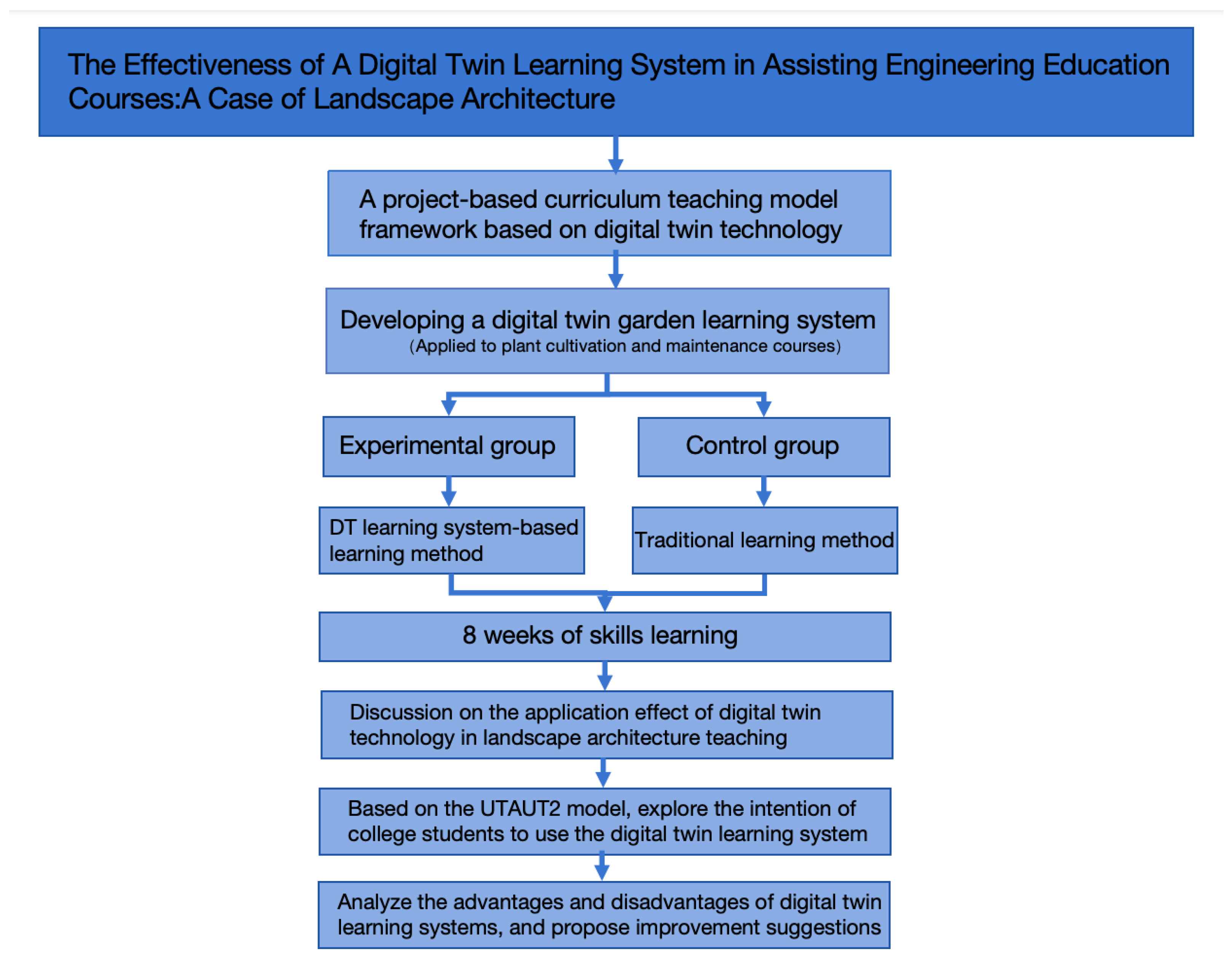
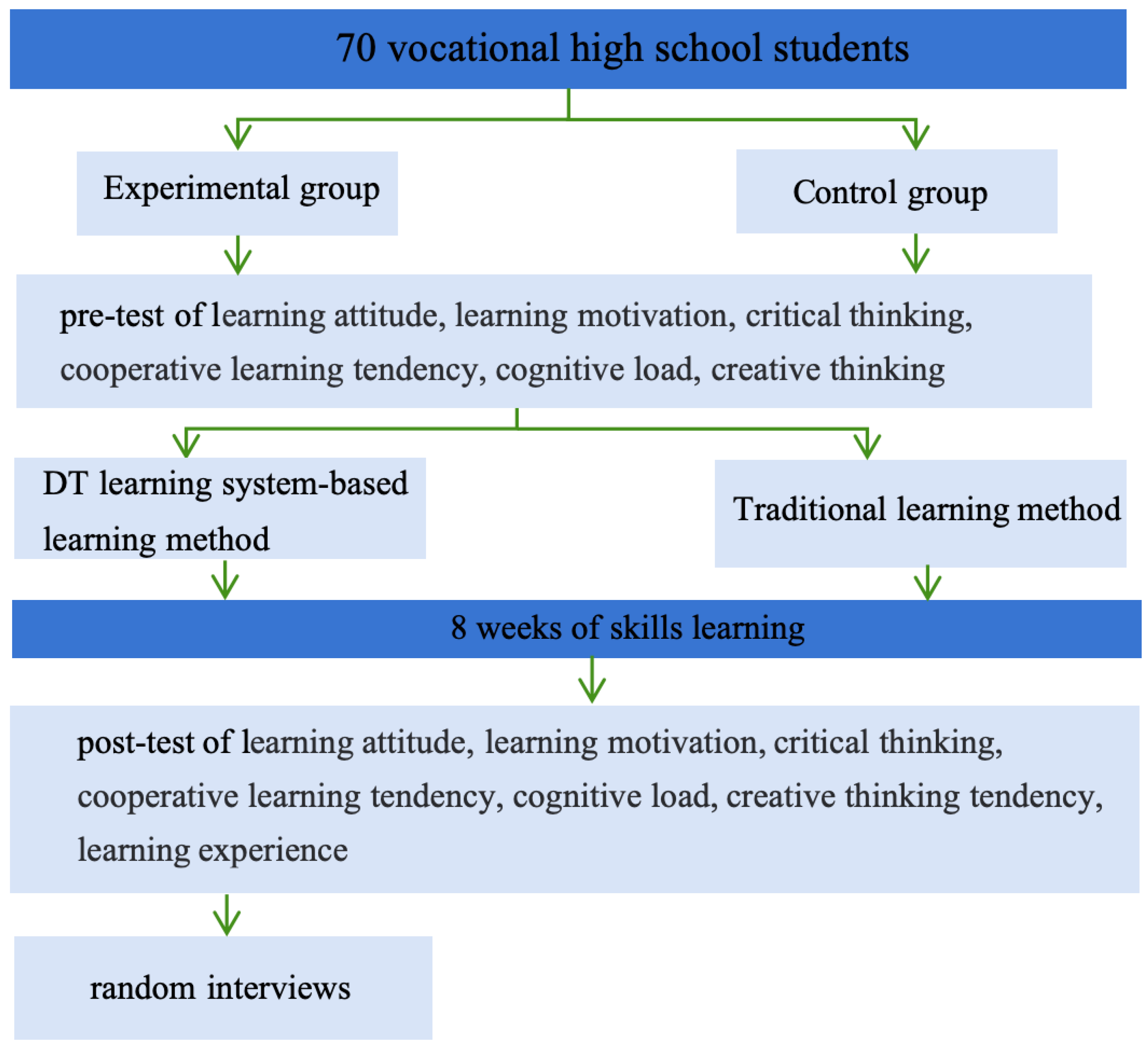
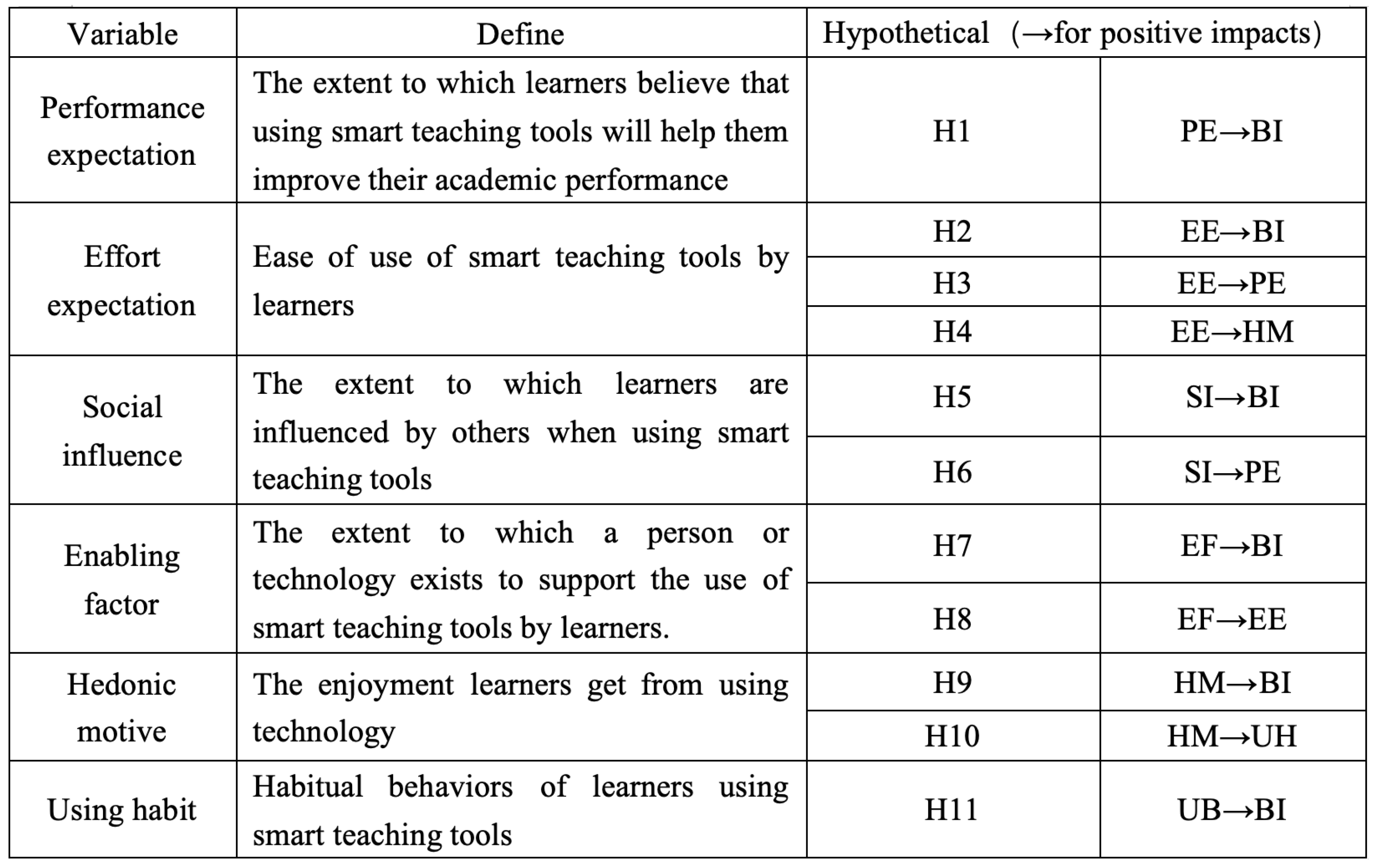
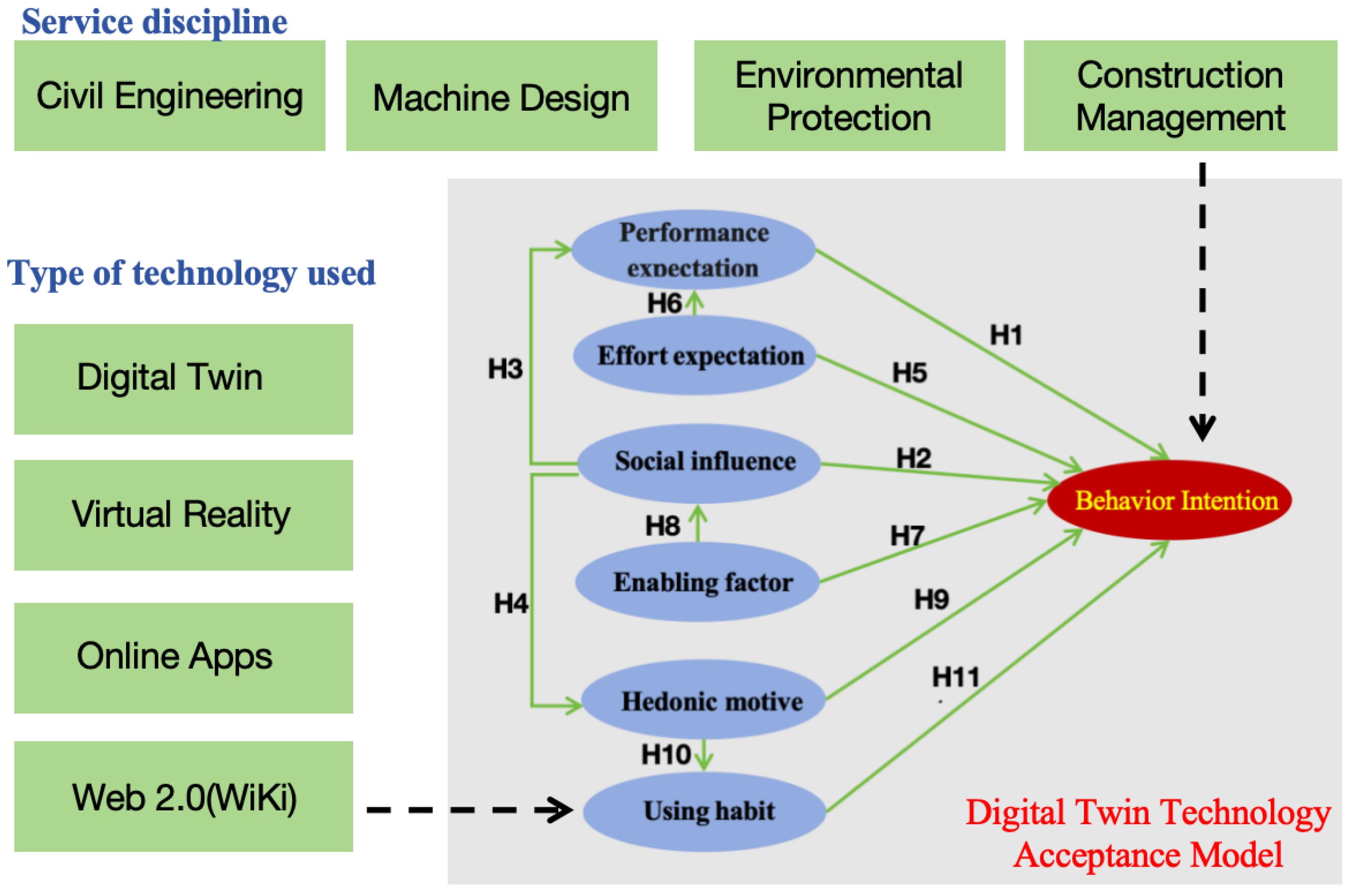
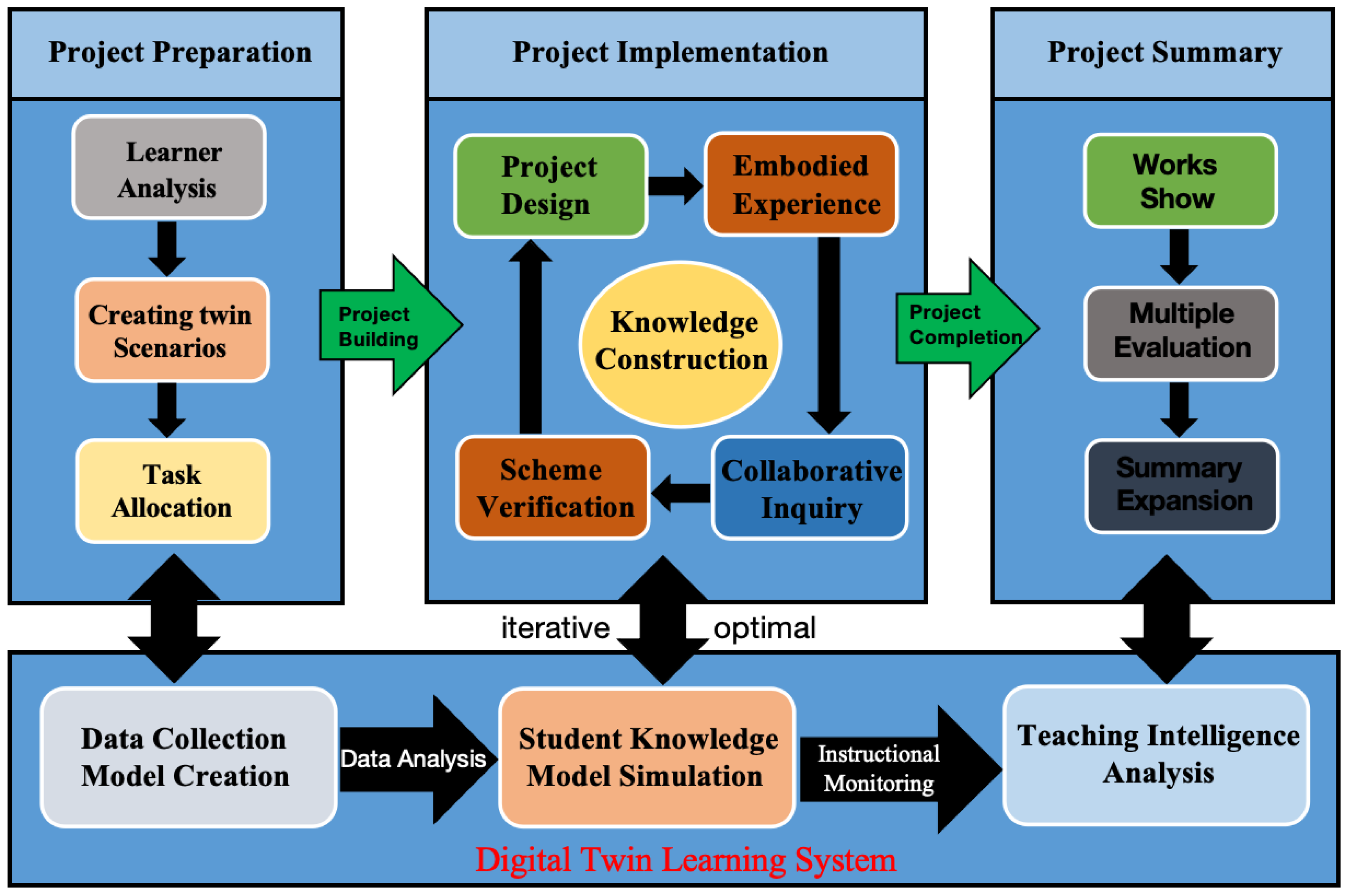
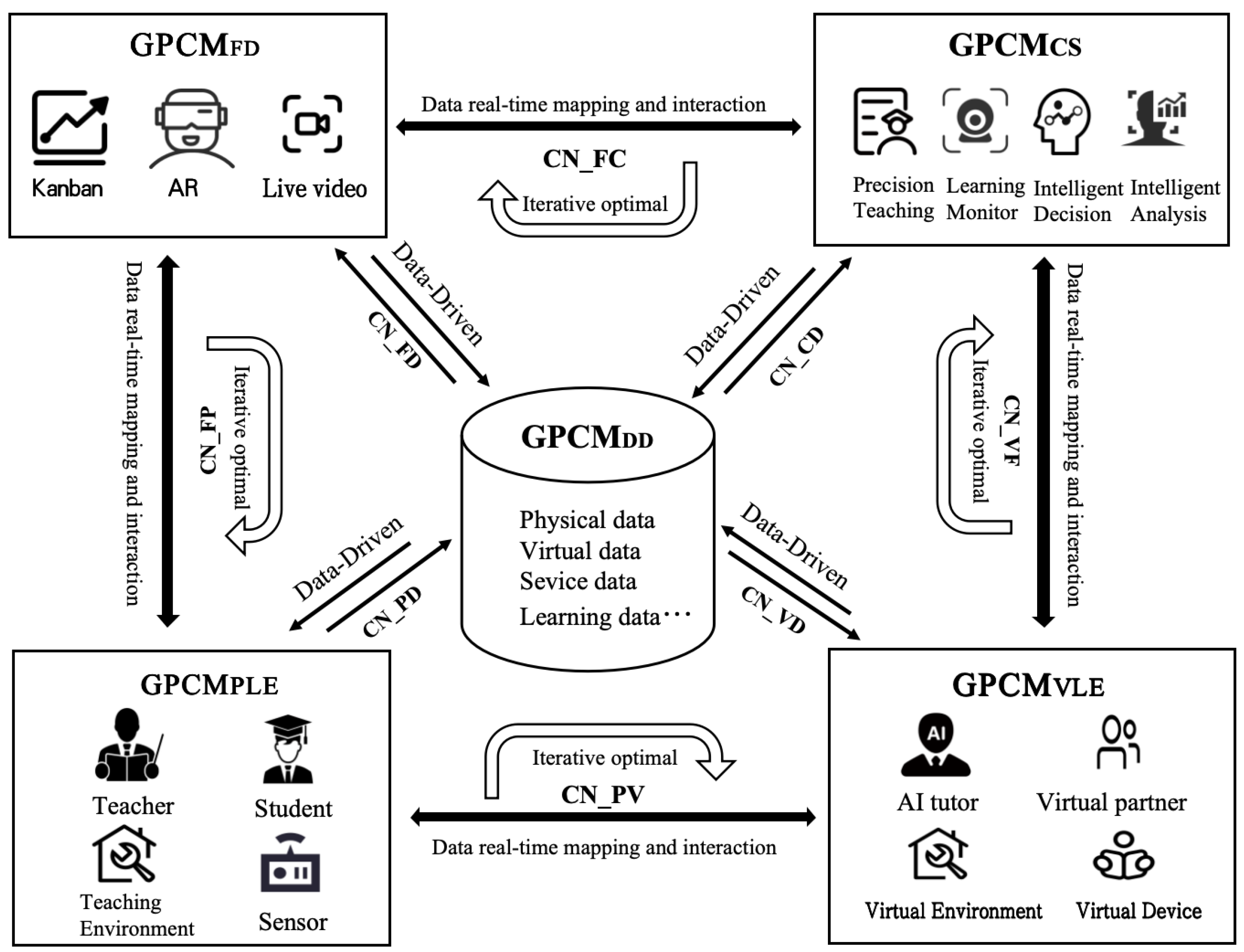
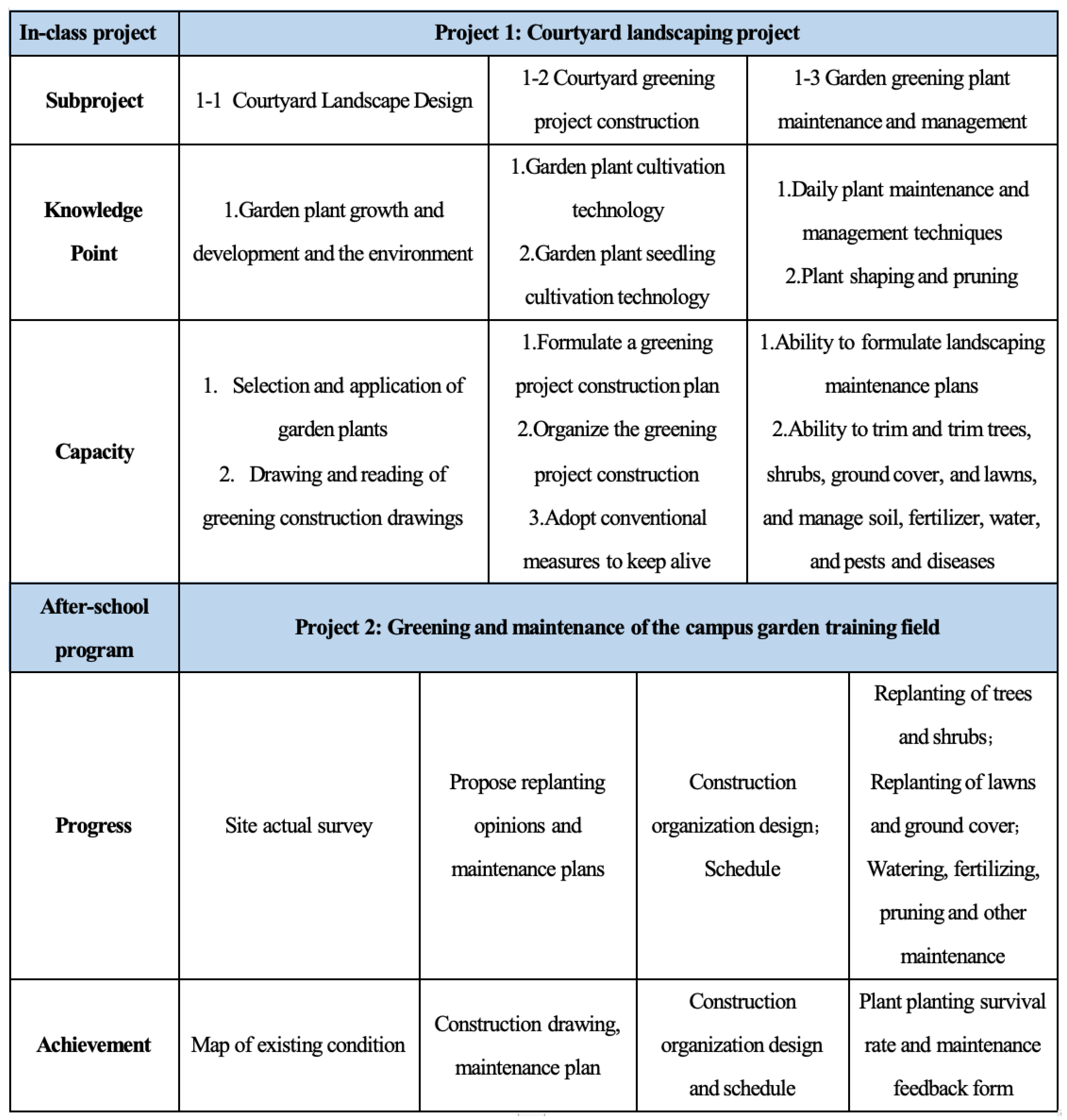
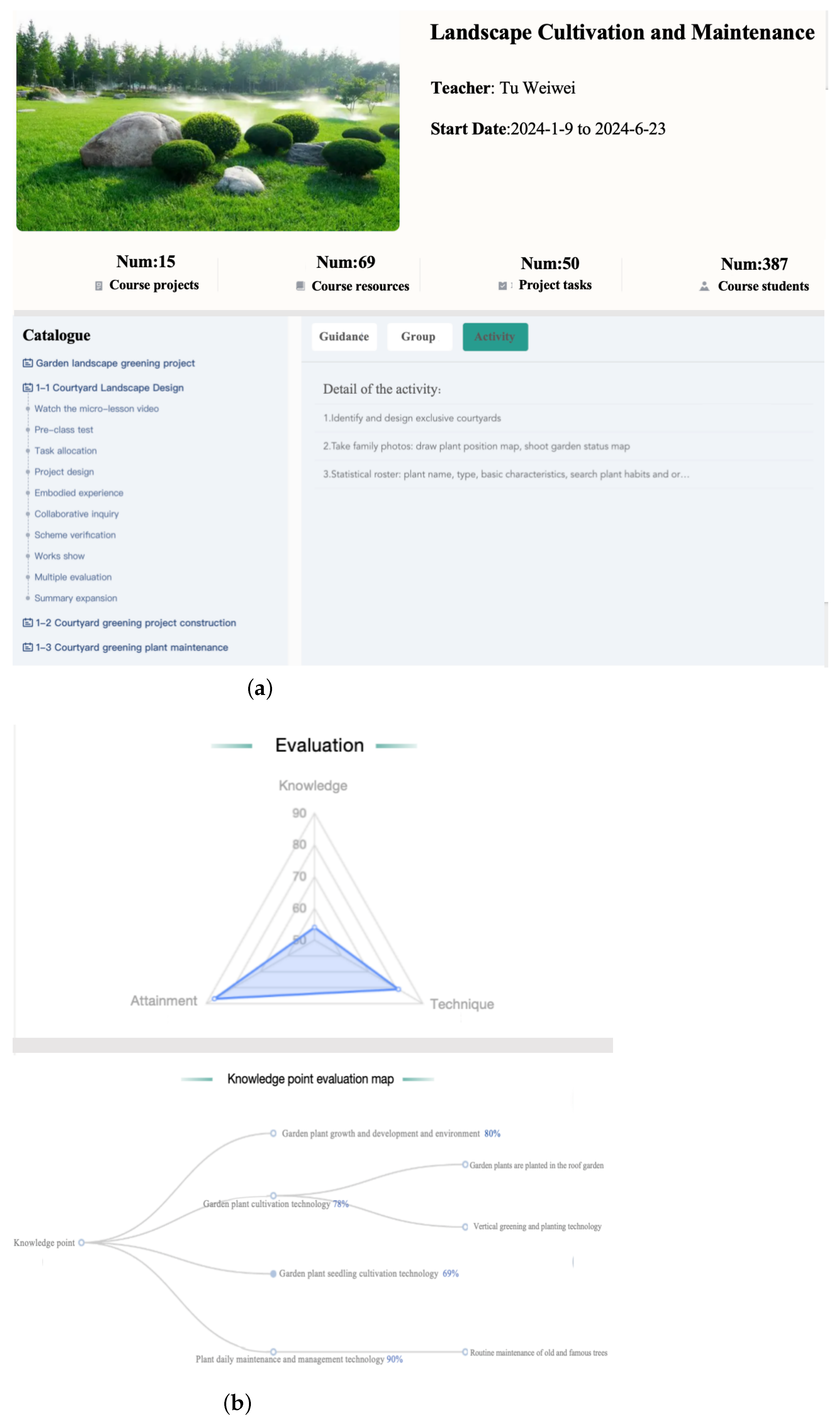
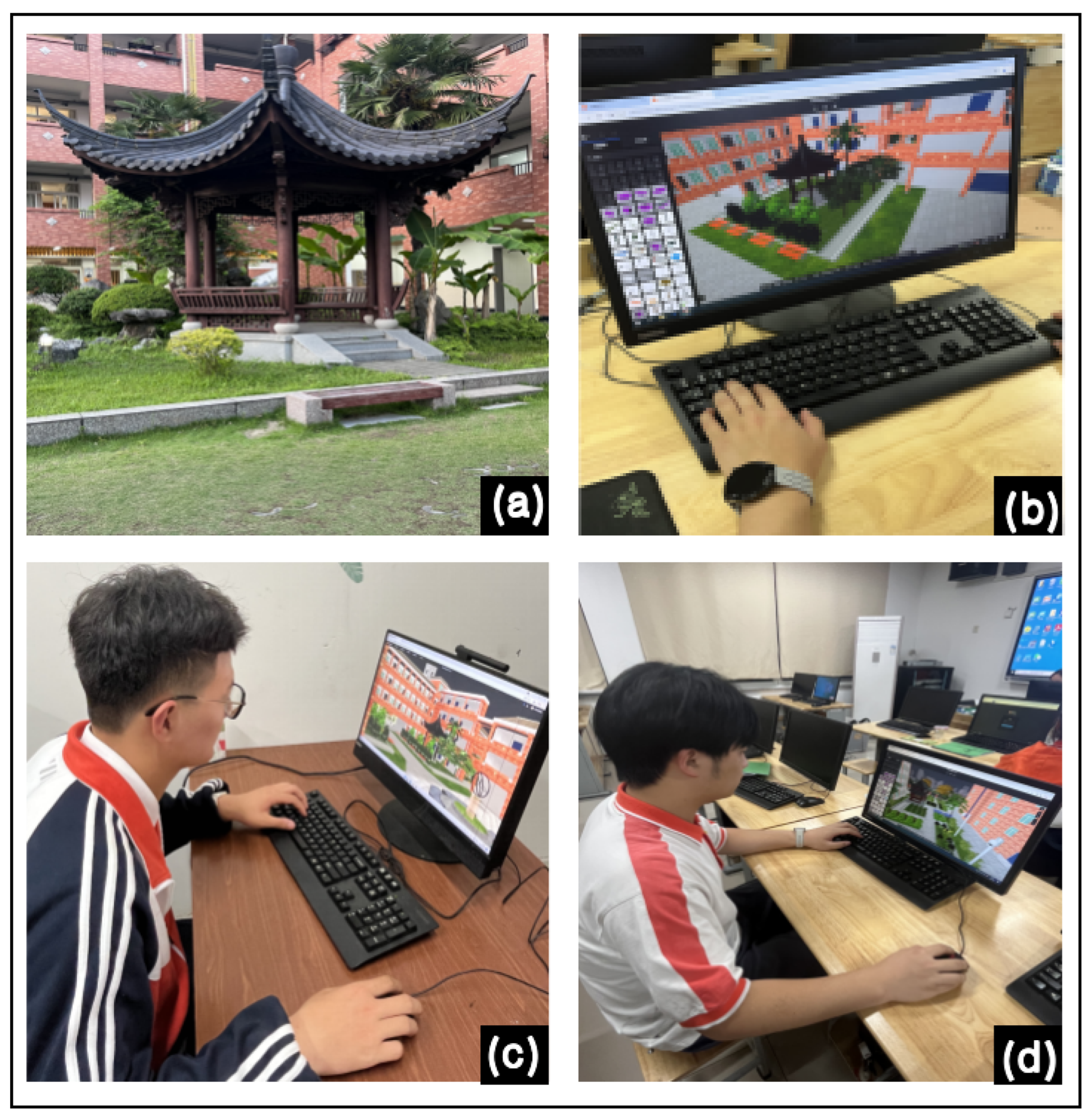
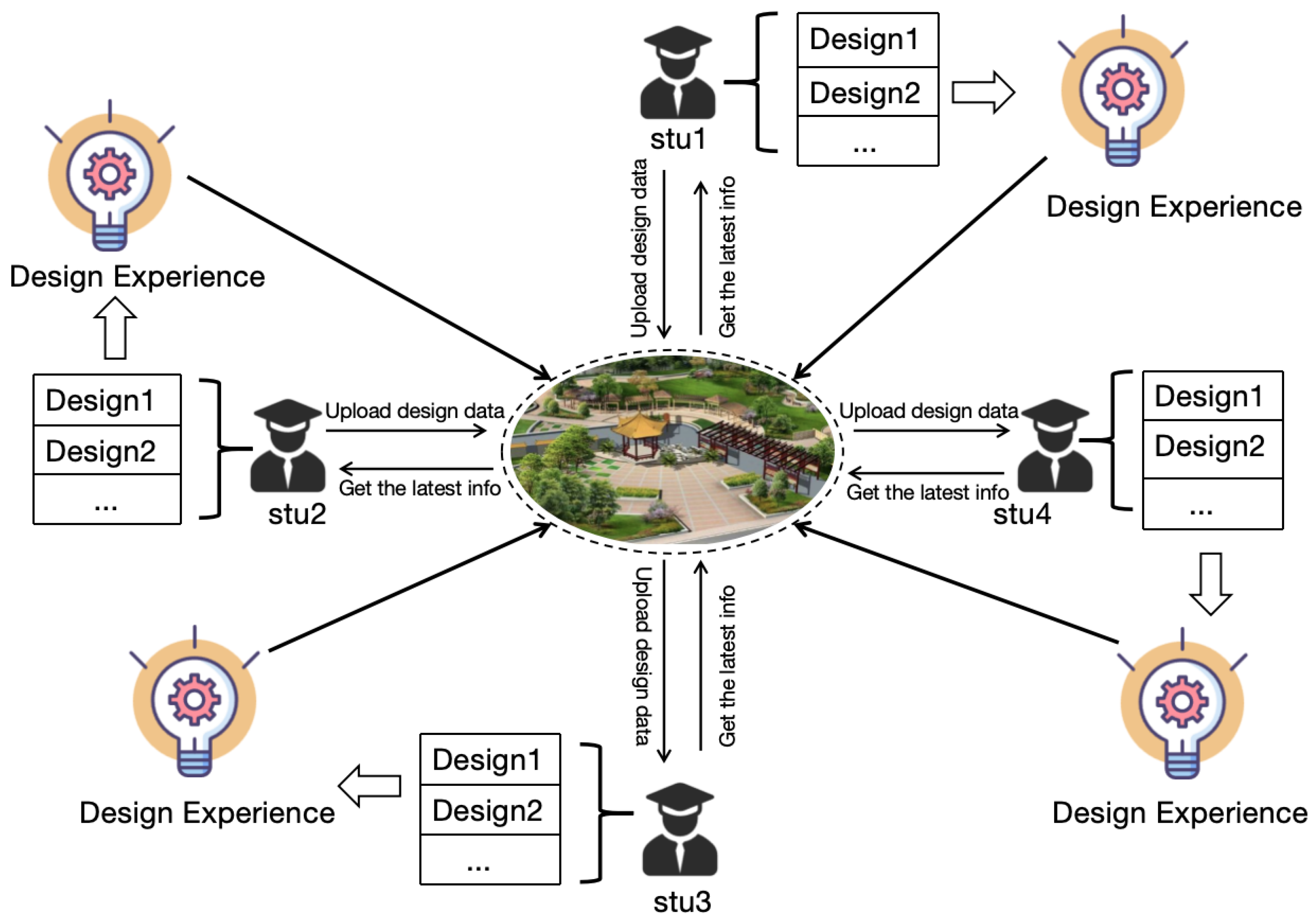
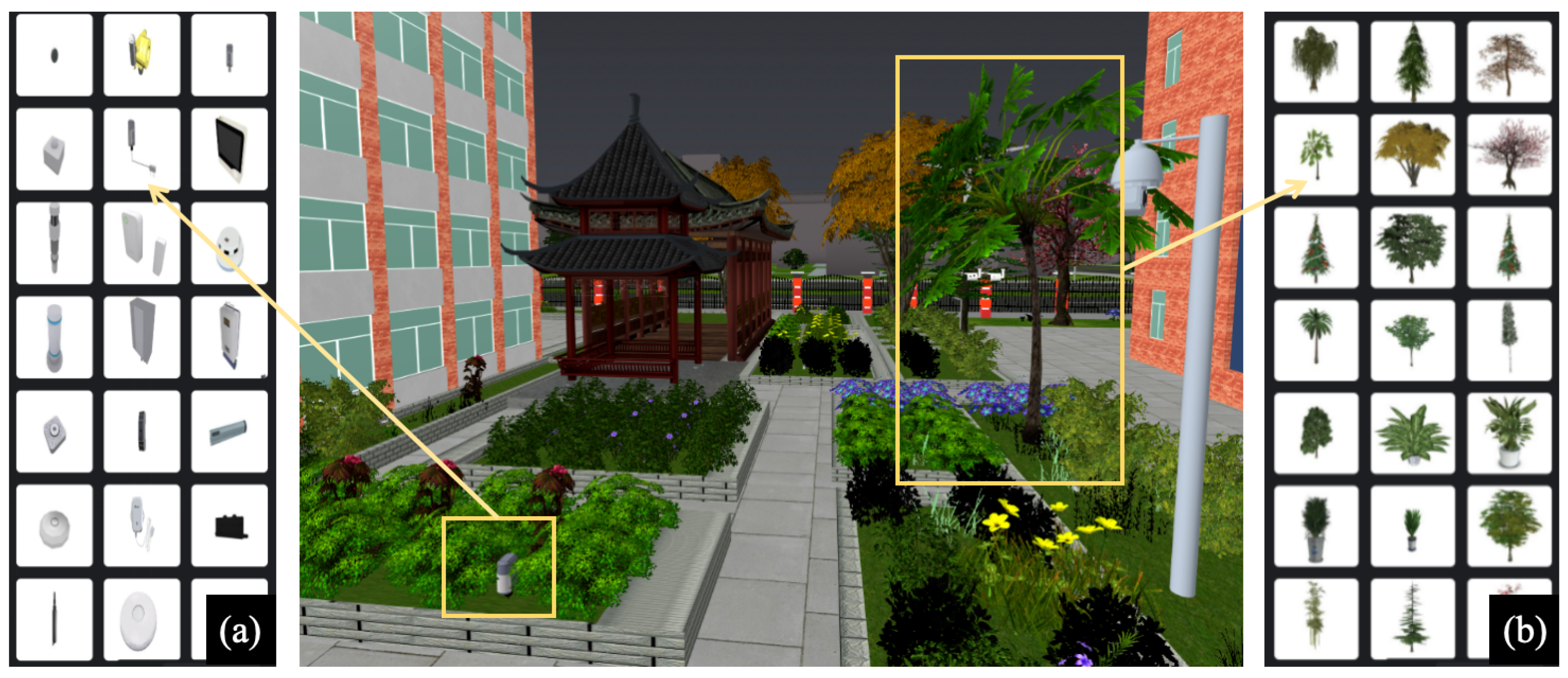
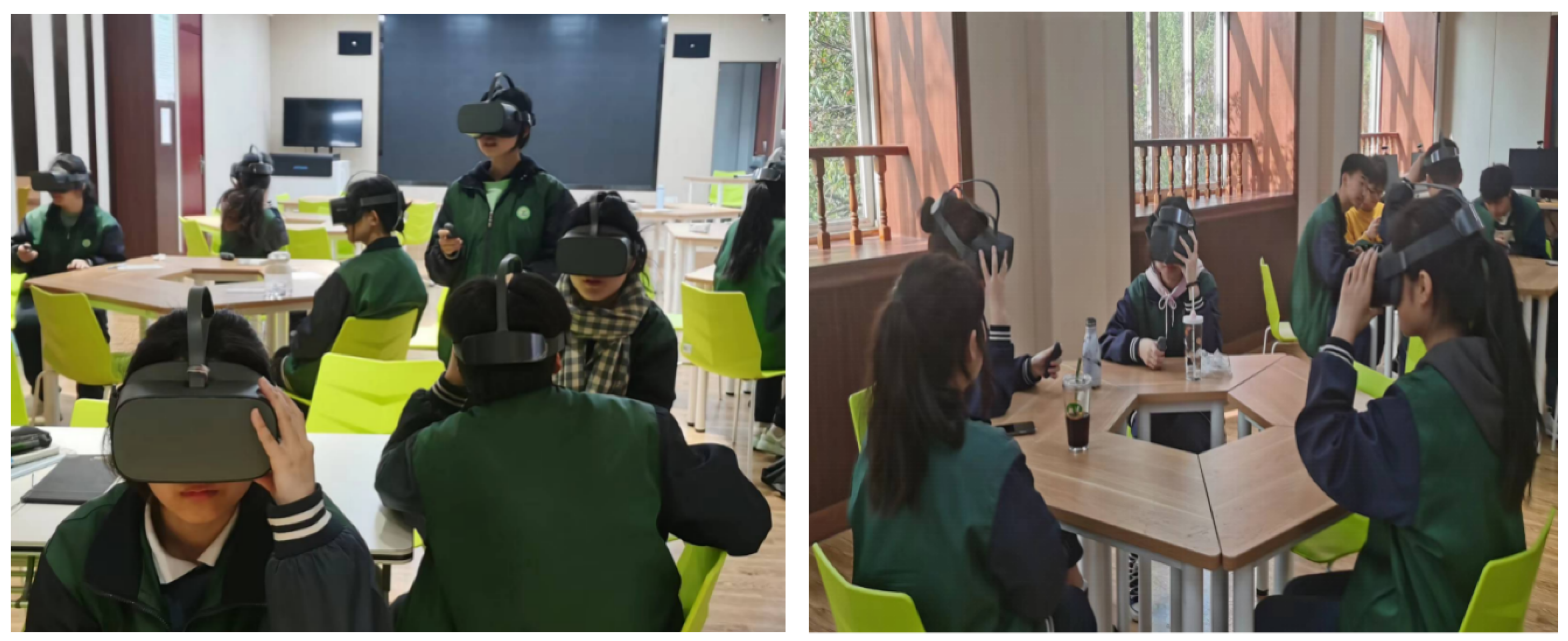
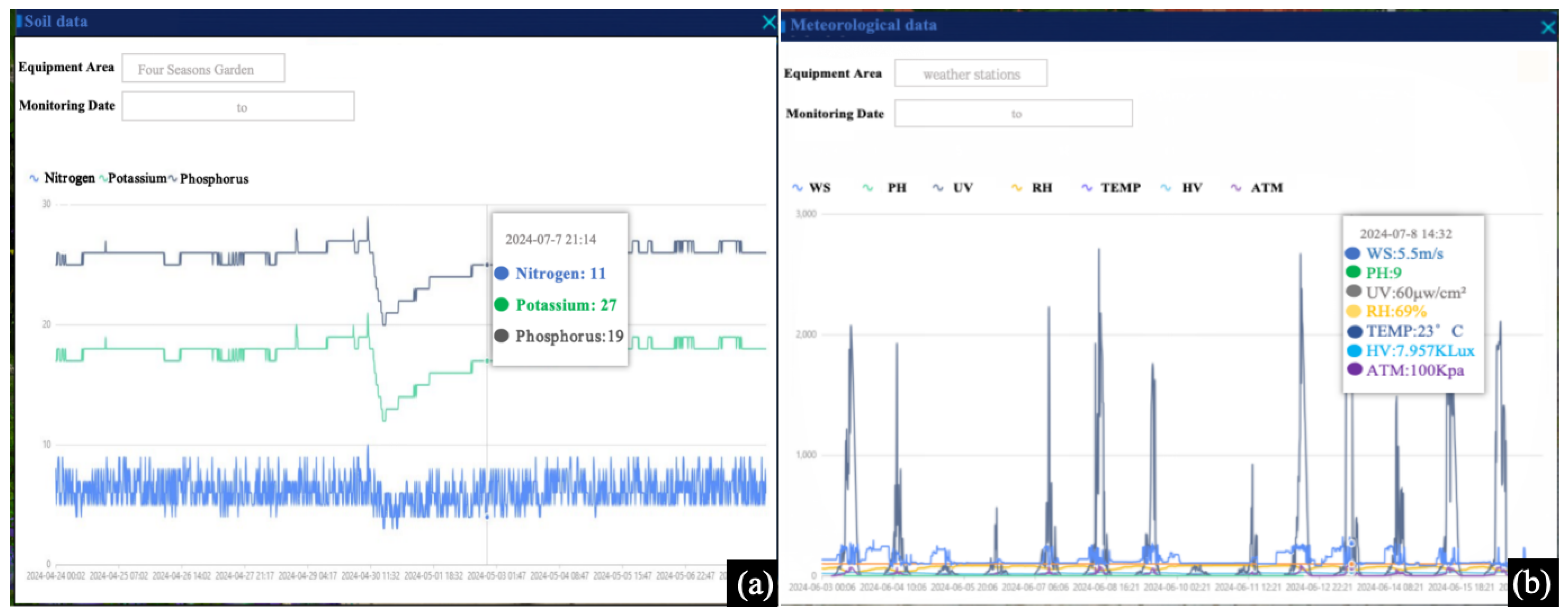
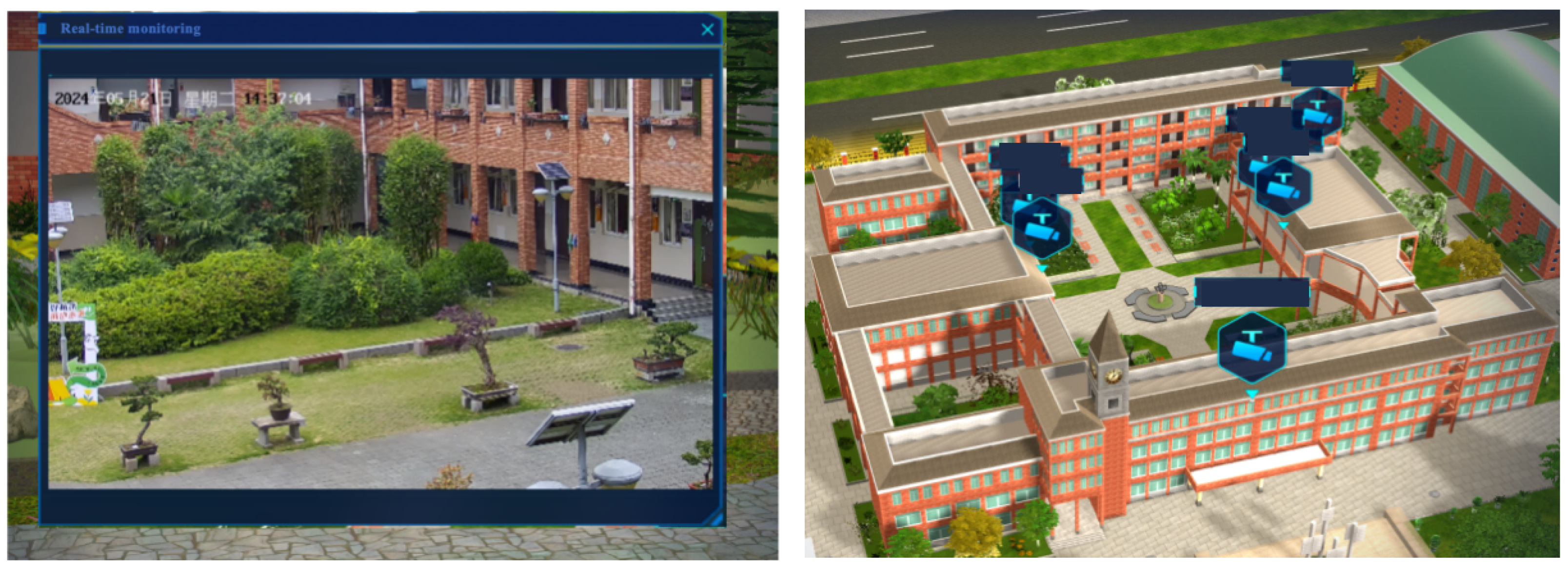

| Vaicance | Group | N | Mean | SD | t | p |
|---|---|---|---|---|---|---|
| Creative thinking | Experimental | 35 | 10.46 | 1.874 | 0.343 | 0.645 |
| Control | 35 | 10.23 | 1.133 | |||
| Critical thinking | Experimental | 35 | 21.66 | 3.245 | 2.142 | 0.034 * |
| Control | 35 | 19.78 | 3.649 | |||
| Cooperative learning | Experimental | 35 | 12.52 | 1.763 | 2.146 | 0.029 * |
| Control | 35 | 11.47 | 1.548 | |||
| Cognitive load | Experimental | 35 | 10.45 | 1.678 | −2.435 | 0.012 * |
| Control | 35 | 11.34 | 1.694 | |||
| Learning experience | Experimental | 35 | 12.74 | 2.438 | 2.056 | 0.032 * |
| Control | 35 | 10.86 | 1.973 | |||
| Learning motivation | Experimental | 35 | 11.56 | 2.134 | 1.237 | 0.178 |
| Control | 35 | 10.98 | 2.087 | |||
| Academic record | Experimental | 35 | 89.65 | 11.34 | 3.762 | 0.000 *** |
| Control | 35 | 72.14 | 13.65 |
| Dimension | Index | Standard Load | Cronbach’s Alpha | CR | AMOS |
|---|---|---|---|---|---|
| Performance expectation | PE1 | 0.753 | 0.834 | 0.872 | 0.541 |
| PE2 | 0.836 | ||||
| PE3 | 0.698 | ||||
| Effort expectation | EE1 | 0.583 | 0.712 | 0.724 | 0.502 |
| EE2 | 0.694 | ||||
| EE3 | 0.732 | ||||
| Social influence | SI1 | 0.684 | 0.762 | 0.753 | 0.453 |
| SI2 | 0.586 | ||||
| SI3 | 0.648 | ||||
| Enabling factor | EF1 | 0.754 | 0.812 | 0.819 | 0.535 |
| EF2 | 0.768 | ||||
| EF3 | 0.643 | ||||
| Hedonic motive | HM1 | 0.796 | 0.857 | 0.845 | 0.703 |
| HM2 | 0.724 | ||||
| HM3 | 0.719 | ||||
| Using habit | UH1 | 0.865 | 0.834 | 0.875 | 0.634 |
| UH2 | 0.821 | ||||
| UH3 | 0.783 | ||||
| Behavior Intention | BI1 | 0.782 | 0.826 | 0.845 | 0.652 |
| BI2 | 0.725 | ||||
| BI3 | 0.810 |
| Hypothetical Path | Beta | SE | CR | p | Inspection Results |
|---|---|---|---|---|---|
| HM ← EE | 0.865 | 0.143 | 9.354 | *** | remarkable |
| PE ← EE | 0.376 | 0.125 | 2.532 | ** | remarkable |
| UH ← HM | 0.782 | 0.053 | 10.351 | *** | remarkable |
| EE ← EF | 0.834 | 0.056 | 9.431 | *** | remarkable |
| PE ← SI | 0.652 | 0.127 | 6.578 | *** | remarkable |
| BI ← PE | 0.276 | 0.145 | 2.347 | * | remarkable |
| BI ← EE | −0.349 | 0.315 | −2.237 | * | remarkable |
| BI ← SI | 0.067 | 0.167 | 0.645 | 0.512 | unremarkable |
| BI ← EF | 0.458 | 0.148 | 2.643 | * | remarkable |
| BI ← HM | 0.165 | 0.087 | 1.258 | 0.125 | unremarkable |
| BI ← UH | 0.574 | 0.056 | 8.033 | *** | remarkable |
Disclaimer/Publisher’s Note: The statements, opinions and data contained in all publications are solely those of the individual author(s) and contributor(s) and not of MDPI and/or the editor(s). MDPI and/or the editor(s) disclaim responsibility for any injury to people or property resulting from any ideas, methods, instructions or products referred to in the content. |
© 2024 by the authors. Licensee MDPI, Basel, Switzerland. This article is an open access article distributed under the terms and conditions of the Creative Commons Attribution (CC BY) license (https://creativecommons.org/licenses/by/4.0/).
Share and Cite
Zhang, J.; Zhu, J.; Tu, W.; Wang, M.; Yang, Y.; Qian, F.; Xu, Y. The Effectiveness of a Digital Twin Learning System in Assisting Engineering Education Courses: A Case of Landscape Architecture. Appl. Sci. 2024, 14, 6484. https://doi.org/10.3390/app14156484
Zhang J, Zhu J, Tu W, Wang M, Yang Y, Qian F, Xu Y. The Effectiveness of a Digital Twin Learning System in Assisting Engineering Education Courses: A Case of Landscape Architecture. Applied Sciences. 2024; 14(15):6484. https://doi.org/10.3390/app14156484
Chicago/Turabian StyleZhang, Jie, Jingdong Zhu, Weiwei Tu, Minkai Wang, Yiling Yang, Fang Qian, and Yeqing Xu. 2024. "The Effectiveness of a Digital Twin Learning System in Assisting Engineering Education Courses: A Case of Landscape Architecture" Applied Sciences 14, no. 15: 6484. https://doi.org/10.3390/app14156484





